Small Number and the Old Canoe – Heiltsuk
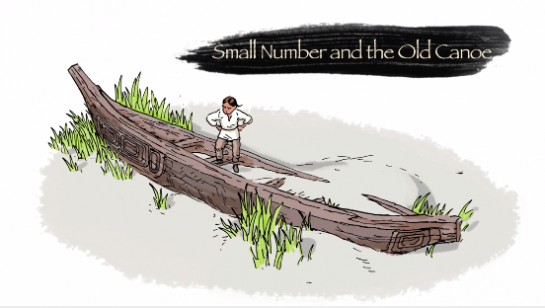
Written by Veselin Jungic & Mark MacLean
Illustrated by Simon Roy
In Small Number and the Old Canoe, mathematics is present throughout the story with the hope that this experience will make at least some members of our young audience, with the moderator’s help, recognize more mathematics around them in their everyday lives. Using terms like smooth, shape, oval, and surface, and mathematical phraseology like It must be at least a hundred years old, the artist skillfully presents reflection (symmetry) of trees in water, and so on. The idea behind this approach is to give the moderator a few openings to introduce or emphasize various mathematical objects, concepts and terminology. The short film is a little math suspense story and our question is related only to one part of it. The aim of the question is to lead to an introduction at an intuitive level of the concept of a function and the essence of the principle of inclusion-exclusion as a counting technique. The authors would also like to give their audience an opportunity to appreciate that in order to understand a math question, one often needs to read (or in this case, watch) a problem more than once.
Háusayáyu'u du glwa(Heiltsuk Translation)
Heiltsuk Translation by Constance Tallio and Evelyn Windsor
Story Transcript: English and Heiltsuk
Small Number and the Old Canoe – Haulaæas - Háusa du gl„a
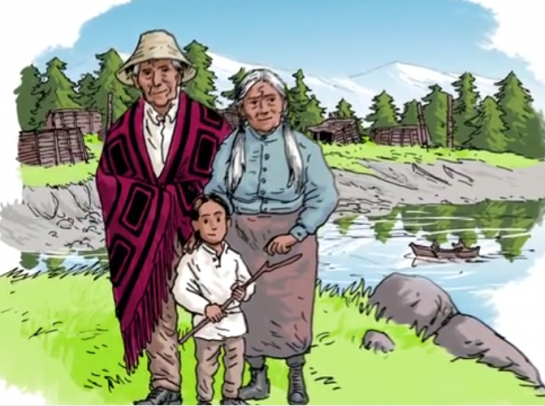
Small Number is a little boy,
Haulaæa’uis wísm háusláya.
And he is always getting into mischief,
Gi hiálaœam nánúætuba la.
He is in the care of his grandparents.
’Císlasuis ©aq©¡pási,
for they put up with the way he plays.
’Ksa¥asi wáñiqas hialama Óám¬ínisi.
Grandpa has to carve a feast dish,
’Kiágilaxv ©a©mpasi æúœva ßiálaçiÒ.
Go out and play with the other children
Gi Óauá yápa háusªá’ qn láisi, Óámæuls du „áukvas þiþapxv,
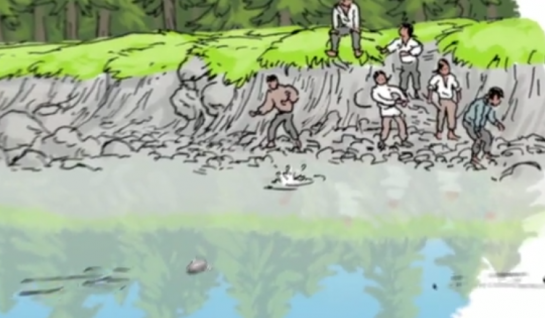
It’s a nice spring sunny day
HáixÒalapsis ha¥¢þs pxlas ðvqªá,
And they ran down to play in the water.
gi Óauá ðíðþvnçs lá Óámæa la „a’ámpaþi,
everything they see sparks a new game
’Hákœa²ás duqvlasusi wáli œáyaþ’aidailas Óáluæts Óám¬íní,
And Small Number’s friend Big Circle suggests they see who can make a stone skip the farthest on the surface of the water.
Gi Óauá œa¥aþ’ait ’Qaikasas klxsm qn ÓágvaÒia¥alanás †ísm gila çþ’áitsi la „a’ampaþi,
The boys learned if they want their stones to go far, they had to use a flat oval shape stone.
Há¬akaiœa’ áuæ’aÒªa wi’ísmáþi ñaþvi msªá qn þvísgílís †ísm hiá©lmsi yíáqægilá¥asi paætus glætúxs†uxvs tism
Small Number walked far looking for the rock that will win.
Yiálaglis Háuláæas Háusªá þvíþvsgílá líta †ísmáts Óáikuá¥u
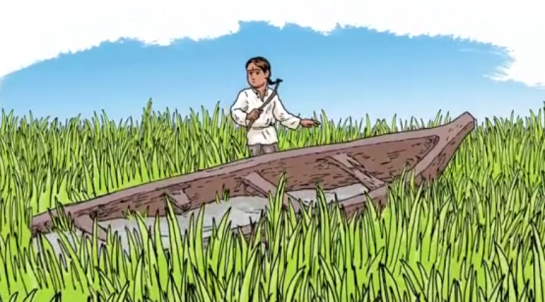
He was walking in the grassy area and he kicked into something, and fell head first into an old canoe hidden in the grass.
Tuá laglisi la ðít¡isaþi gi Óauá œáœnþÞála µnúxvs µás. Kíþçu xváðvná guædia †á¥álá la ð톙áþi.
Even if he hit his head he was very happy over his find
Waxv’™i ƒuxválá háix†iási gi „alas Óáiðqªas œákanþvasi.
He called out to his friends, they went running to him
Yáuþvªi „áukvasi gi Óaua ðíðvªá lákáqi
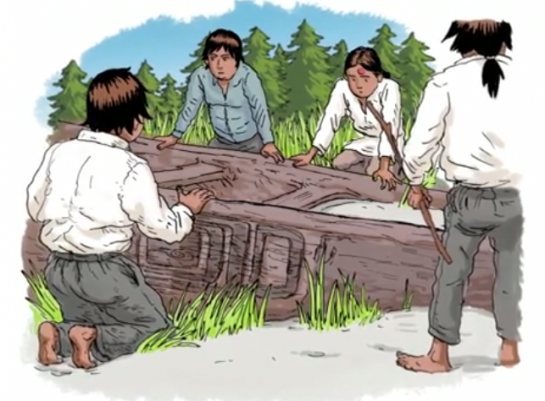
The boys were standing around the canoe
ßaxßuis wi’í™áþi la „uistayas xvákvÞáyaþi
They were touching the sides of the canoe
’Pakaxdaþvu wuwakiaþsiþs xvákvÞáyaþv
I look old and look big to them
©aialaxs†uxv’ila œáikas†uxv
Small Number asks
Gi Óauá haúmá Háuláæas Háusªá
How many people do you think will fit in there, asked Big Circle.
G¢caukvi dítgváÞm xvuti¥aus qn haiæþv láþv ’quik ñix k¬xsm
How many generations ago was it built?
G¢acáukviþndilic ’ÒíÒu„lstuá la¥acþv þsílásu
The boys forgot the game they had been playing
’ƒlístaœam wi’ísmáþv Óám¬íná¥asi
They were talking about the canoe wondering who could have used it.
Gi Óauá pðváláœams gl„áyáþi œa’áuƒiþsda yiaqæats gl„aka’auaþi
As they were talking Big Circle’s tummy began to growl
La bípðválá¥asi ’Qvúm¬áláx’it tðiás ’Qáikas K¬xsm
I’m hungry “Let’s go eat”, he says to his friends.
Pu„ís™Þúgva ’waixsints hmsa, niki „áukvasi
And they all ran home
Gi hauá ðíkþv’it lái ñakv
Small number ran home
’Kíþvla Haulaæas háusªá láiñakv
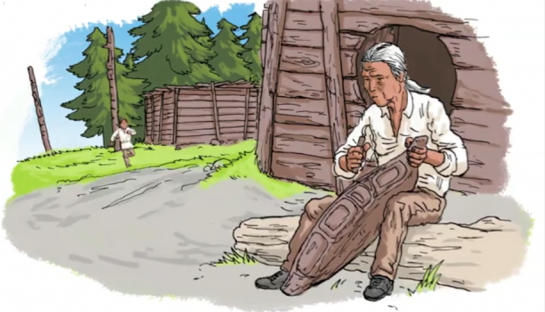
At the place where grandpa was carving the surface of a huge (wooden) dish
La la’asas ©a©™pasi ðiálagiæ wus©mi¥as œáikaska’áuás æúœva
And he shouted
Gi Óauá Óátªá
And he looked up
Gi Óauá †iþsísta dúþv’it
He saw the bruise on Small Number’s forehead
Dúqvªái Óáxváyá la „úgvíwáyas háuláæas háusªá
What happened asked grandpa
’Wíx’ítxdas nix ©á©má háum
Small Number had forgotten that he bumped his head and started to tell Grandpa about finding the canoe
’Òlísta háulaæas háuslá-ya la¥asi †s’ála háix†iási, gi niæas qaka¥si gø„a
I found an old canoe down on the beach. It must be at least a hundred years old.
’Qákánúgva gl„a gvauæ la wi¬iaþi laganmits „ú¹nxstáis’ila „ásålásasi
Granpa smiled, it was one of the fastest canoes of our village.
Møxvlá ©á©ámpa œa’áuÒÞugva gø„áyáþi Mnúkvis yixálágvuts gø„as qnts gvúkviásaþ.
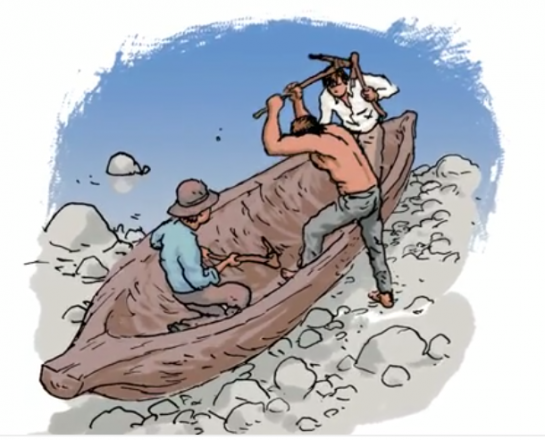
It was built by my father and two of his brothers.
’Háƒasugvauæis qs Óaumpa du má’álukvas „aœvásí
Grandpa proudly continued, all the sons of my grandfather were known as the great carvers
Níætu ©á©mpa gi níæas ’hágám sásmás qs ©á©má œa’áuƒnþvs yis „alas Óáikímás ðiá
You know those three (old) totem poles in front of the bighouse
’Ga’áuæ’msu qi yúdúkvas çu„áþsi la „u„áþsiás ßiáçiaþi
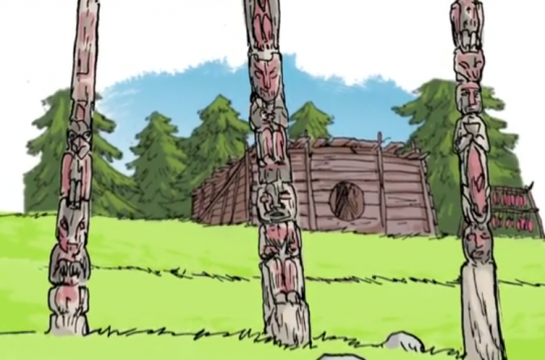
Each of them was built by one of my uncles
’Hágámi ðiásus qs µnúkvas xvæmp
One evening before going to sleep, Small Number thought, I’d like to build a canoe and totem poles just like my ancestors
Mnúkvis ©ánúæ Óábas laxstasaiæa¥asi qn ðaæ’it ÿxsílíþsdnugva du ’cu„áþsigila ©viála qs Óáiámbiægvaiædia.
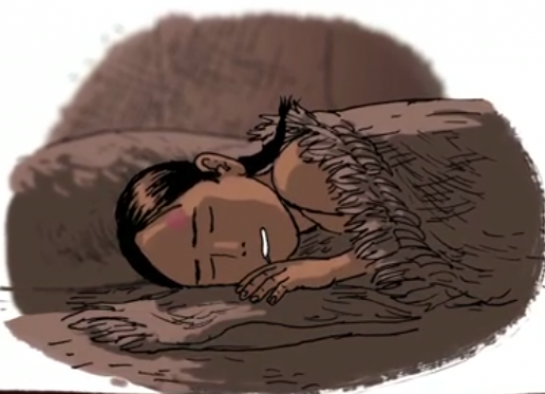
I will ask my grandfather tomorrow how many brothers his father had, two, three, four, five or more
HáumáÒÞugva ©á©má æansÒats gncaukv „í„aœváyaci Óaumpasi, ma’alukv, yúdúkv, múkv, sðaukv, duñaþvi œáinám.
Question: Why did Small Number think his great grandpa had two, three, four, five great grandparents?
’Mási xvútagiæts háuláæ’uas háusªá qits ma’áluxv, yúdúxv, múxv, sðåúxv ©á©as¬ayats ©á©mpasi.
Credits and Acknowledgements
- Written by: Veselin Jungic, SFU and Mark MacLean, UBC
- Illustrator: Simon Roy, Victoria, B.C.
- Director: Andy Gavel, Simon Fraser University
Special thanks to:
- Tom Archibald, Simon Fraser University
- Peter Jacobs, Squamish Nation
- Ozren Jungic, University of Oxford
- Kwosel, Seabird Island First Nation
- Kwelaxtelot, Seabird Island First Nation
- Susan Russell, Simon Fraser University
- Erin Tait, Nisga'a Nation
- Department of Mathematics, Simon Fraser University
- Faculty of Science, Simon Fraser University
- The IRMACS Centre, Simon Fraser University
- Office for Aboriginal Peoples, Simon Fraser University
- Pacific Institute For Mathematical Sciences
This story is part of the NSERC PromoScience project "Math Catcher: Mathematics Through Aboriginal Storytelling"
Financial support provided by NSERC, PIMS, UBC, the IRMACS Centre, and SFU

